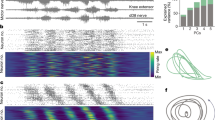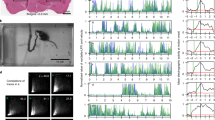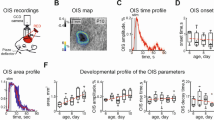Abstract
The first movements of the fetus are apparently random and spontaneous1,2. Their onset coincides with the growth of dorsal root afferents into the spinal cord3,4 and it is possible that they are not simply a result of spontaneous motoneuron activity but are reflex responses to sensory stimulation5. It is not clear what stimuli could normally evoke such reflexes because nothing is known of the properties of primary afferent neurons in the fetus. I have investigated this by making recordings from single dorsal root ganglion cells in fetal rats in vivo. The afferents have small, defined receptive fields and respond to mechanical stimulation of skin or muscle at intensities that might occur in utero. Many of them are also chemosensitive. Unlike postnatal afferents they display background activity which peaks at the same age as fetal movements. Repeated stimulation causes long-lasting increases of both background and evoked activity. Such sensory input is likely to have a considerable influence on fetal movements and on the development of spinal cord connections.
This is a preview of subscription content, access via your institution
Access options
Subscribe to this journal
Receive 51 print issues and online access
$199.00 per year
only $3.90 per issue
Buy this article
- Purchase on Springer Link
- Instant access to full article PDF
Prices may be subject to local taxes which are calculated during checkout
Similar content being viewed by others
References
Angulo y Gonzalez, A. W. J. comp. Neurol 55, 395–442 (1932).
Narayanan, C. H., Fox, M. W. & Hamburger, V. Behaviour 40, 100–134 (1971).
Altman, J. & Bayer, S. A. The Development of the Rat Spinal Cord (Springer, Berlin, 1984).
Smith, C. L. J. comp. Neurol 220, 29–43 (1983).
Windle, W. F. The Physiology of the Foetus (Phildalephia, 1940).
Fitzgerald, M. J. Physiol, Lond. 383, 79–92 (1987).
Lynn, B. & Carpenter, S. E. Brain Res. 238, 29–43 (1982).
Diamond, J. & Nurse, C. A. Neuroscience 11, 509–520 (1984).
Zelena, J. J. Embryol. exp. Morph. 5, 283–289 (1957).
Bradley, R. M. & Mistretta, C. M. Physiol Rev. 55 352–382 (1975).
Fulton, B. P. Neurosci. Lett. 73, 125–130 (1987).
Author information
Authors and Affiliations
Rights and permissions
About this article
Cite this article
Fitzgerald, M. Spontaneous and evoked activity of fetal primary afferents in vivo. Nature 326, 603–605 (1987). https://doi.org/10.1038/326603a0
Received:
Accepted:
Issue Date:
DOI: https://doi.org/10.1038/326603a0
This article is cited by
-
Developmental waves of mechanosensitivity acquisition in sensory neuron subtypes during embryonic development
The EMBO Journal (2009)
-
Resting Discharge Patterns of Macular Primary Afferents in Otoconia-Deficient Mice
Journal of the Association for Research in Otolaryngology (2008)
-
The development of nociceptive circuits
Nature Reviews Neuroscience (2005)
Comments
By submitting a comment you agree to abide by our Terms and Community Guidelines. If you find something abusive or that does not comply with our terms or guidelines please flag it as inappropriate.



